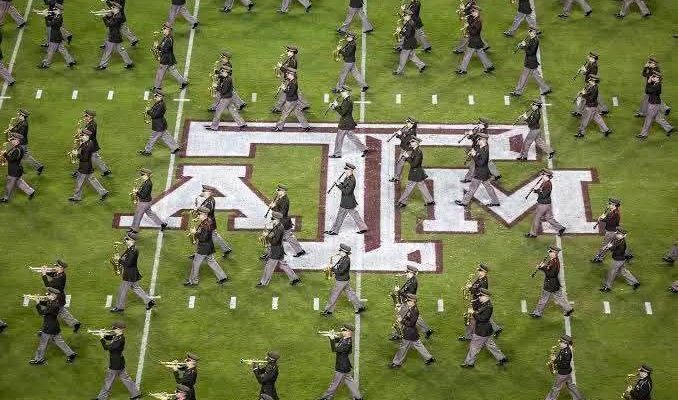The spirit of college football isn’t just about the game, the touchdowns, or even the bitter rivalries—it’s about the atmosphere, the tradition, the noise, and the spectacle. And at the heart of that spectacle lies the soul-stirring energy of the college marching band. In that realm, no name rings louder this week than Texas A&M. In what can only be described as a performance for the ages, the Texas A&M Aggies Marching Band has just been crowned the #1 Marching Band of All Time, sending shockwaves through the world of sports, music, and higher education alike. A title like this isn’t just bestowed lightly—it’s earned through years of relentless discipline, tradition, and excellence. But this wasn’t just a culmination of decades of hard work. This was a singular performance so transcendent, so intricately choreographed, so powerful in sound and precision, that ESPN analysts labeled it “The Greatest Ever Seen.” And the internet? It exploded.
To truly understand the magnitude of this achievement, you need to understand what makes the Texas A&M Aggies Marching Band not just great, but legendary. Unlike many college bands that prioritize entertainment through pop culture medleys and dance-inspired choreography, Texas A&M’s band maintains a strict military style rooted deeply in tradition. Every step is measured, every note disciplined, and every formation a stunning exercise in geometry and coordination. It’s the kind of performance where precision isn’t just a goal—it’s a demand. The Fightin’ Texas Aggie Band, as it’s officially known, has never once swayed from this legacy.
So when the band took the field for the 2025 National College Band Showcase at the Rose Bowl this past weekend, expectations were already high. Thousands in the stadium rose to their feet as the brass thundered to life and the drumline snapped like a crack of thunder across the field. But no one—absolutely no one—was prepared for what followed. Over the next 12 minutes, the Aggie Band executed a performance of such synchronized complexity and power that it felt like a masterclass in both music and motion. They formed moving stars, rotating eagles, and even a perfectly timed replica of the Texas state seal—all while never missing a beat or faltering in tempo.
The visuals were jaw-dropping, but it was the sound that sealed their legacy. The brass rang out in commanding waves. The woodwinds cut like lasers through the chilly Pasadena air. And the drumline? Flawless. Not a single stick drop, not a single note out of place. The musical selection wasn’t a typical greatest-hits compilation either. Instead, they paid tribute to American resilience with pieces ranging from Aaron Copland’s “Fanfare for the Common Man” to an original arrangement inspired by the music of John Philip Sousa. The crescendos hit like fire, the silences hit like truth.
What separates Texas A&M’s band from the rest is the philosophy behind the performance. It’s not showbiz—it’s service. Every member of the band is a part of the Corps of Cadets, the university’s military training program. Their uniform is not a costume; it’s a representation of dedication to discipline, leadership, and excellence. In a world where flash often overrides substance, the Aggie Band continues to demonstrate that deep-rooted tradition and elite craftsmanship can still take center stage.
It didn’t take long for the internet to take notice. Within minutes of their performance, social media erupted. Clips flooded TikTok, YouTube, X (formerly Twitter), and Instagram. Hashtags like #AggieBandGOAT and #UnmatchedPrecision began trending globally. Celebrities and sports personalities alike began sharing the footage. ESPN anchor Rece Davis called it “the finest execution of marching precision I’ve ever witnessed.” Stephen A. Smith, never one to mince words, declared it “a masterpiece of American collegiate culture.” Even rival school band directors—many of whom have competed against A&M for decades—were left speechless. One anonymous Big Ten band director said in a leaked message, “We just watched the Sistine Chapel of marching band performances. They’ve set a bar none of us may ever reach.”
What may be even more telling than the praise is the global response. International media picked up the performance, with outlets in the U.K., Japan, and Brazil airing segments on it. Military academies worldwide reportedly asked for footage for instructional purposes. Music educators hailed it as a teaching tool. In essence, this wasn’t just an American college band making headlines—it was a global showcase of what the human spirit, united in discipline and art, can achieve.
The victory has also reignited debates about the role of marching bands in collegiate culture. Over the past decade, many schools have shifted toward more commercial-style halftime shows, with pop songs, flashy dancers, and digital effects. While that certainly entertains, there’s something timeless and awe-inspiring about the kind of grounded, militaristic precision Texas A&M continues to champion. In fact, music historians argue that the Aggie Band represents the last living vestige of traditional military-style college marching bands in the United States. Their ongoing commitment isn’t just nostalgic—it’s historical preservation.
At a time when so many elements of tradition are being reimagined or discarded, the Aggie Band’s performance serves as a bold reminder that excellence doesn’t need reinvention—it needs mastery. And mastery is exactly what the world witnessed.
Let’s talk about what makes this group so special at a logistical level. The Fightin’ Texas Aggie Band is one of the largest military-style marching bands in the country, often numbering over 400 members. Each student must undergo rigorous training both musically and physically. Members rehearse several hours daily, sometimes before sunrise, executing drills and refining their instrument handling. Mistakes aren’t tolerated—not in a cruel way, but in a manner that builds unity and sharpens excellence. The culture isn’t one of fear—it’s one of shared responsibility and pride.
There’s also an educational value embedded in everything the band does. In interviews with current band members, many have stated that their time with the Aggie Band has been more formative than any lecture hall. They’ve learned leadership, time management, critical thinking, and perseverance. When you have to march in 90-degree Texas heat for hours, while maintaining tempo and formation, quitting is never an option. That mentality stays with them, far beyond the field.
The ripple effect of this moment is undeniable. Applications to Texas A&M’s Corps of Cadets are reportedly seeing a surge. The music program is experiencing newfound interest. Alumni donations have spiked. One donor reportedly pledged $2 million to fund expanded scholarships for band members, stating, “That performance wasn’t just a show—it was a statement about the kind of young leaders we should be investing in.”
And of course, the students themselves are taking it all in stride. In a post-performance interview, Drum Major Jacob Salinas was humble but confident. “We don’t do this for fame. We do it because we believe in something bigger than ourselves—tradition, honor, service. The recognition is nice, but the real reward is knowing we left everything on the field.”
That sentiment captures the essence of what the Fightin’ Texas Aggie Band represents. It’s not about spectacle for spectacle’s sake—it’s about carrying forward a legacy with precision, pride, and power. And now, that legacy has been etched in history as the best of the best.
But what does this mean for the future of marching bands nationwide? Already, there are signs of a cultural shift. University music departments are rethinking their band programs. Students are asking for more structure and more challenge. Band directors are reconsidering their show formats. Texas A&M has, perhaps unintentionally, sparked a renaissance. It’s no longer just about entertaining the crowd—it’s about pushing the limits of human coordination and musical performance.
As we look back on this historic moment, it’s clear that this wasn’t just a great performance. It was a benchmark. An exclamation mark on a tradition that’s been refined through the decades. The Texas A&M Aggies Marching Band didn’t just win a title—they inspired a movement. In a world that often feels fragmented and chaotic, their unity, discipline, and sound brought people together. That’s more than music. That’s leadership.
And maybe that’s the real power of what the Aggie Band accomplished. Not just precision or tradition or national attention—but inspiration. In every step they took on that field, in every note that soared into the evening sky, they reminded the world that greatness isn’t an accident. It’s the product of purpose, persistence, and passion. And for that, they deserve every bit of the praise they’re getting.
So here we are, witnessing history. The Texas A&M Aggies Marching Band, crowned #1 of all time, not just for what they did in one show—but for what they’ve stood for across generations. It’s a moment that will live in college folklore forever. The Aggies didn’t just march—they roared. And the world stood still and listened.



